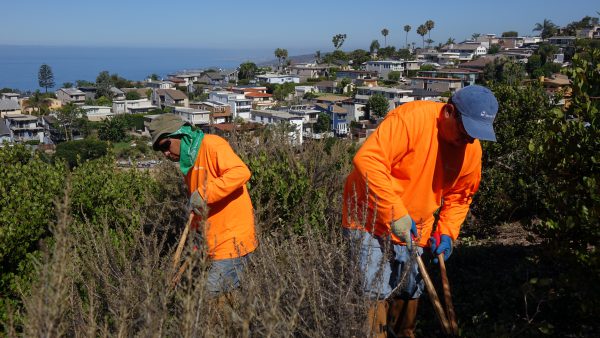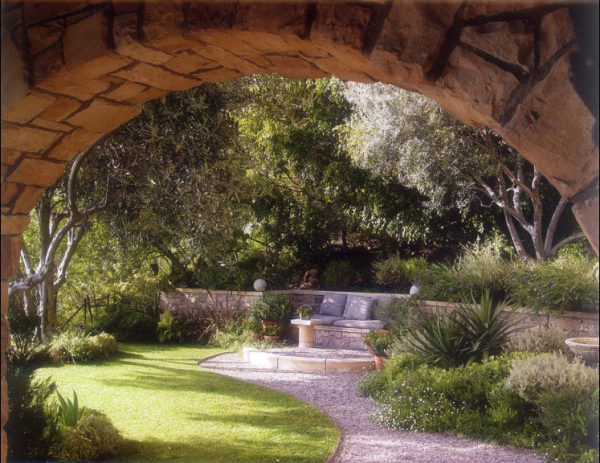
Laguna Beach took a step Tuesday toward adopting wildfire-resistant landscaping rules that city officials argue will help prevent flames from jumping to homes and give firefighters room to work safely.
The Laguna Beach City Council voted 4-1 (Councilmember George Weiss opposed) to approve changes to city law requiring homeowners to remove dead vegetation and trim trees and shrubs. These local wildfire defense space requirements apply to about 87% of the city’s residential properties that sit in the Very High Fire Hazard Severity Zone—a ribbon of neighborhoods next to Coast Highway from Emerald Bay to Diamond Street are outside of this zone and would be exempt.
As of July 1, Assembly Bill 38 requires all homes sold within the Very High Fire Hazard Severity Zone must undergo a fire safety inspection report. If a city or county hasn’t adopted its own regulations, homeowners must comply with strict guidelines created by the California Dept. of Forestry and Fire Protection, which includes the removal of all flammable ground cover and shrubs within 30 feet of all structures.
Homebuyers can commit to completing all the necessary maintenance within a year of closing escrow, fire officials said.
Critics have voiced a slate of grievances ranging from private property rights to concerns about removing shade amid climate change to a lack of definitive exceptions for well-irrigated gardens.
These arguments didn’t deter the council majority.
“We have to live in the world we find ourselves in not the one we want to live in,” Mayor Pro Tem Sue Kempf said. “There are a lot of people who don’t manage their vegetation and they need to be compliant.”
In the wake of devastating blazes like the Camp Fire and Dixie Fire, Kempf also highlighted that many insurance companies are denying fire policies for Laguna Beach homeowners.
Fire Chief Mike Garcia said fire officials are complying with the new state law and have already performed 39 home inspections for property owners looking to sell. He emphasized that his department is attempting to help residents avoid more draconian state mandates with a plan that’s more considerate of what local community members want.
“What we want to do for the next few years is we want to go heavy with education,” Garcia said. “We believe through simple modifications that can still be beautiful—and I know there’s differences of opinion on that—but really with simple modifications our community can be more safe.”
Among the most debated parts of the new city law is the maintenance of shrubs and trees. Within five feet of a structure, trees must be trimmed to reduce the canopy by 30% from its unmaintained state. Within that same radius from a home, ornamental and native shrubs need to be relocated or tinned to provide no more than 50% coverage
Likewise, trees between five and 30 feet from a structure must be trimmed to reduce the canopy by 30% from its unmaintained state.

Tree advocates have said the vistas residents have come to enjoy would be transformed by the requirement to thin tree canopies by nearly a third.
Among the troubling elements for Weiss was fire officials’ nebulous promise to look at how well a property is irrigated during inspections.
“It seems to me you’re giving consideration for irrigation but what does that mean?” Weiss said. “It doesn’t mean anything. It just says consideration. That’s not a measurable thing. So one day it could be this [and] another day it could be that.”
Ultimately, he argued the proposal needed better vetting with residents. The Fire Department hosted a July 14 workshop to receive community input and the Emergency and Disaster Preparedness Committee has discussed the plan at public meetings for months.
Laguna Beach resident Barbara Metzger was among the community members who expressed concerns about the guidelines in July, saying the city’s plan is not as manageable as rules in the state fire code.
“The Fire Department’s proposed regulations go far beyond them, and while they’re called a ‘guideline’ they consistently use the word ‘shall’ and appear intended to be required,” she wrote. “The blanket reduction of trees and shrubs cover to 30% not only will cover be devastating aesthetically but directly contradicts the worldwide imperative of increasing tree cover to reduced climate change.”
Garcia emphasized that the defensive space guidelines are designed to help protect homes and firefighters amid normal behavior. However, wind-blown fires are have recently moved faster and burned hotter than ever before. Embers carried by Santa Ana winds could blow well ahead of the fire, potentially endangering homes outside of the wildland-urban interface where homes meet scrub-filled open space.
Bill Niccum, a Laguna Beach resident and retired Los Angeles County Fire assistant chief, said the proposed ordinance is a step in the right direction. Niccum recently joined the Emergency and Disaster Preparedness Committee, which also voted Sept. 13 to support the guidelines.
“Now is the time for all of us as homeowners to step up and shoulder some of the responsibility if needed to protect the community we’re calling home,” Niccum said.
The defensible space ordinance is scheduled to return for a second procedural vote on Oct. 5. if finally approved, it would take effect on Nov. 1.





“all flammable ground cover and shrubs within 30 feet of all structures.” is rather draconian, anything burns given the right conditions. It means moving trees to the center of driveways.
“30% of unmaintained state.” The 30-30 rule for tree trimming is reasonable but vague. Does it mean tree topping, tree spacing, void space, by weight, all the above? The FD will necessarily guide by inspections.
Good intentions by our State and FD, fire prevention is easier/proactive/cheaper than fire protection.